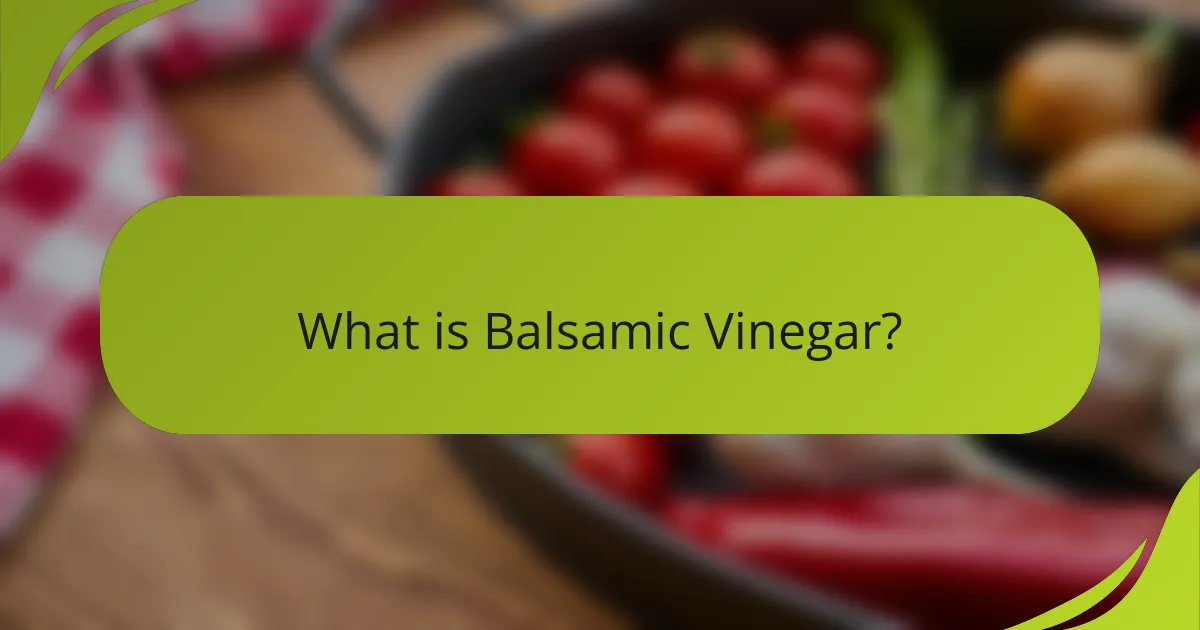Balsamic vinegar is a dark, sweet-sour condiment from Italy, crafted from cooked grape juice and aged in wooden barrels for several years. This article explores the various types of balsamic vinegar, highlighting its culinary applications in salad dressings, marinades, and glazes for meats and vegetables. Additionally, it examines the health benefits associated with balsamic vinegar, such as its antioxidant properties, digestive support, and potential role in blood sugar regulation. The distinct flavor and versatility of balsamic vinegar make it a valuable ingredient in both home and professional kitchens.

What is Balsamic Vinegar?
Balsamic vinegar is a dark, sweet-sour vinegar originating from Italy. It is made from freshly crushed grape juice, which is then cooked down and aged. Traditional balsamic vinegar undergoes a lengthy aging process in wooden barrels, often lasting several years. This aging process develops its complex flavors and rich aroma. Balsamic vinegar is typically used in salad dressings, marinades, and as a finishing touch for various dishes. The quality of balsamic vinegar can vary significantly, with traditional varieties being more expensive due to their intricate production methods. The distinct taste and versatility make balsamic vinegar a popular ingredient in both home and professional kitchens.
How is Balsamic Vinegar made?
Balsamic vinegar is made through a process of fermentation and aging. It begins with freshly crushed grape must, which is the juice, skins, and seeds of the grapes. This must is cooked down to concentrate its flavors and sugars. The cooked must is then fermented using natural yeasts.
After fermentation, the vinegar undergoes a lengthy aging process in wooden barrels. This aging can last from several months to several years, allowing the flavors to develop. Traditional balsamic vinegar is often aged for a minimum of 12 years.
The aging process imparts complex flavors and a thick consistency. The final product is a rich, dark vinegar with a unique taste profile. This method of production has been practiced in Modena, Italy, for centuries, ensuring authenticity and quality.
What are the key ingredients in Balsamic Vinegar?
Balsamic vinegar primarily consists of grape must and wine vinegar. Grape must is freshly crushed grape juice, including the skins, seeds, and stems. This mixture is cooked down to concentrate its flavors. Wine vinegar is made through the fermentation of wine. The combination of these two ingredients creates the distinct sweet and tangy flavor profile of balsamic vinegar. Traditional balsamic vinegar is aged for several years, enhancing its complexity. This aging process allows for the development of rich flavors and a thicker consistency.
What is the fermentation process of Balsamic Vinegar?
Balsamic vinegar undergoes a fermentation process that transforms grape must into a complex condiment. Initially, freshly crushed grape juice, known as must, is cooked down to concentrate its sugars. This cooked must is then placed in wooden barrels for fermentation. Natural yeasts present in the environment convert the sugars into alcohol. Following this, acetic acid bacteria convert the alcohol into acetic acid, giving balsamic vinegar its characteristic tang. The fermentation process can take several months to years, depending on the desired flavor profile. Traditional balsamic vinegar is aged in a series of wooden barrels, which imparts unique flavors from the wood. The result is a rich, complex vinegar with a balance of sweetness and acidity.
What are the different types of Balsamic Vinegar?
There are several types of balsamic vinegar. The main types include Traditional Balsamic Vinegar, which is produced in Modena and Reggio Emilia, and is aged for a minimum of 12 years. Another type is Commercial Balsamic Vinegar, which is often blended with wine vinegar and has a shorter aging process. Additionally, there is Balsamic Vinegar of Modena IGP, which is a regulated product that must meet specific criteria. Each type varies in flavor, sweetness, and complexity. Traditional varieties are typically thicker and more concentrated. Commercial types are more accessible and widely used for everyday cooking.
How do Traditional and Commercial Balsamic Vinegars differ?
Traditional balsamic vinegar is made from freshly crushed grape must and aged for a minimum of 12 years in a series of wooden barrels. In contrast, commercial balsamic vinegar often contains wine vinegar mixed with grape must and is typically aged for a shorter period, sometimes only a few months. Traditional balsamic vinegar has a complex flavor profile, characterized by sweetness and depth, while commercial varieties tend to be more acidic and less nuanced. The production of traditional balsamic vinegar is strictly regulated in Modena and Reggio Emilia, Italy, ensuring high quality and authenticity. Commercial balsamic vinegars may include additives such as caramel color and preservatives, which alter their taste and appearance. The price point also differs significantly; traditional balsamic vinegar is generally much more expensive due to its lengthy production process and quality ingredients.
What are the characteristics of aged Balsamic Vinegar?
Aged Balsamic Vinegar is characterized by its rich flavor, thick consistency, and complex aroma. It is produced through a lengthy fermentation and aging process, often lasting 12 years or more. This vinegar has a deep brown color, indicating its maturity. The aging process occurs in wooden barrels, which impart unique flavors. Aged Balsamic Vinegar is known for its sweetness balanced with acidity. It often has notes of fruit, wood, and spices. The viscosity of aged Balsamic Vinegar allows it to be used as a glaze or finishing touch in dishes. Authentic varieties are regulated by strict standards in regions like Modena, Italy.

What are the culinary uses of Balsamic Vinegar?
Balsamic vinegar is used in various culinary applications. It enhances salads when drizzled over greens or mixed into dressings. Balsamic vinegar can be used as a marinade for meats and vegetables, adding depth of flavor. It complements fruits, especially strawberries and peaches, when used as a topping. Additionally, it serves as a glaze for roasted dishes, providing a sweet and tangy finish. Balsamic vinegar can also be incorporated into sauces and reductions for pasta or grilled items. Its versatility makes it a staple in both traditional and modern cuisine.
How can Balsamic Vinegar enhance dishes?
Balsamic vinegar enhances dishes by adding a rich, complex flavor profile. Its sweetness balances acidity, making it versatile for various cuisines. It can elevate salads, marinades, and glazes. Balsamic vinegar also complements fruits and cheeses, creating unique pairings. The aging process contributes to its depth, with traditional balsamic vinegar often aged for years. This aging results in a thicker consistency and more concentrated flavor. Studies show that balsamic vinegar can also enhance the perception of umami in dishes. Its ability to enrich flavors makes it a staple in gourmet cooking.
What are popular recipes that incorporate Balsamic Vinegar?
Popular recipes that incorporate balsamic vinegar include Caprese salad, balsamic glazed chicken, and roasted vegetables. Caprese salad combines fresh mozzarella, tomatoes, basil, and a drizzle of balsamic vinegar. Balsamic glazed chicken features chicken breasts cooked with a balsamic reduction for a sweet and tangy flavor. Roasted vegetables, such as Brussels sprouts or carrots, can be tossed with balsamic vinegar before baking for added depth. These recipes highlight the versatility of balsamic vinegar in enhancing flavors in various dishes.
How can Balsamic Vinegar be used in dressings and marinades?
Balsamic vinegar can be used in dressings and marinades to enhance flavor and add acidity. It serves as a key ingredient in vinaigrettes, combining it with olive oil, mustard, and herbs. This combination creates a balanced dressing suitable for salads. In marinades, balsamic vinegar tenderizes meat while imparting a sweet and tangy flavor. It pairs well with garlic, herbs, and spices to create a flavorful mixture. Additionally, balsamic vinegar can be reduced to create a glaze, which adds depth to both dressings and marinades. Its versatility makes it a popular choice in culinary applications.
Why is Balsamic Vinegar a versatile ingredient?
Balsamic vinegar is a versatile ingredient due to its complex flavor profile and wide range of culinary applications. It combines sweet and tangy notes, making it suitable for various dishes. Balsamic vinegar can enhance salads, marinades, and sauces. It also works well as a glaze for meats and vegetables. Its ability to balance flavors makes it popular in both savory and sweet recipes. Additionally, balsamic vinegar can be used in dressings, dips, and even desserts. Its rich history dates back to Modena, Italy, where traditional methods of production have been perfected over centuries. This heritage adds to its appeal and versatility in modern cooking.
What flavor profiles does Balsamic Vinegar complement?
Balsamic vinegar complements sweet, savory, and tangy flavor profiles. Its sweetness pairs well with fruits like strawberries and peaches. This vinegar enhances savory dishes, especially those featuring meats and cheeses. It also balances tangy flavors in salads and dressings. Balsamic vinegar’s acidity cuts through richness in creamy sauces. Its versatility allows it to be used in marinades and reductions. This flavor profile enhances the overall taste experience in various cuisines.
How can Balsamic Vinegar be used in desserts?
Balsamic vinegar can enhance desserts by adding a unique tangy sweetness. It pairs well with strawberries, drizzling over fresh fruit to intensify flavors. Balsamic reduction can be used as a sauce for cakes or ice creams. It complements chocolate desserts, balancing sweetness with acidity. Incorporating balsamic vinegar into whipped cream can create a sophisticated topping. Additionally, it can be used in vinaigrettes for fruit salads, providing depth to the dish. Balsamic vinegar’s complexity makes it a versatile ingredient in various dessert recipes.

What are the health benefits of Balsamic Vinegar?
Balsamic vinegar offers several health benefits. It is rich in antioxidants, which help combat oxidative stress in the body. Studies show that these antioxidants may reduce the risk of chronic diseases. Balsamic vinegar also contains acetic acid, which can aid in digestion and improve gut health. Additionally, it may help regulate blood sugar levels, making it beneficial for those with diabetes. Some research indicates that it can promote weight loss by increasing feelings of fullness. Furthermore, balsamic vinegar has anti-inflammatory properties that may contribute to overall health.
How does Balsamic Vinegar contribute to a healthy diet?
Balsamic vinegar contributes to a healthy diet by providing antioxidants and aiding digestion. It is low in calories, making it a healthy alternative to high-calorie dressings. The acetic acid in balsamic vinegar can help regulate blood sugar levels. Studies have shown that it may reduce cholesterol levels and improve heart health. Additionally, balsamic vinegar contains polyphenols, which have anti-inflammatory properties. These compounds can support overall health by reducing oxidative stress in the body. Incorporating balsamic vinegar into meals can enhance flavor without adding unhealthy fats or sugars.
What nutrients are found in Balsamic Vinegar?
Balsamic vinegar contains several nutrients, including acetic acid, antioxidants, and trace minerals. Acetic acid contributes to its distinct flavor and potential health benefits. Antioxidants in balsamic vinegar help combat oxidative stress. Trace minerals such as potassium, calcium, and magnesium are also present in small amounts. These nutrients collectively contribute to its culinary and health applications.
How can Balsamic Vinegar aid digestion?
Balsamic vinegar can aid digestion by promoting healthy gut bacteria. It contains acetic acid, which can enhance the absorption of nutrients. This acid also stimulates the production of digestive enzymes. Improved enzyme activity leads to better breakdown of food. Additionally, balsamic vinegar may help regulate blood sugar levels. Stable blood sugar can prevent digestive discomfort. Studies suggest that vinegar consumption may reduce bloating and gas. Overall, balsamic vinegar contributes positively to digestive health.
What are the potential health risks of consuming Balsamic Vinegar?
Consuming balsamic vinegar can pose several health risks. It is high in acidity, which may lead to digestive issues for some individuals. This acidity can also erode tooth enamel over time. Balsamic vinegar contains sugar, which can contribute to weight gain if consumed in excess. Additionally, it may cause allergic reactions in sensitive individuals. Those with diabetes should monitor their intake due to potential effects on blood sugar levels. Lastly, excessive consumption may lead to gastrointestinal discomfort, including bloating or diarrhea.
Are there any contraindications for certain individuals?
Certain individuals may have contraindications for consuming balsamic vinegar. People with acid reflux or gastroesophageal reflux disease (GERD) may experience worsened symptoms. Diabetics should monitor their intake due to potential effects on blood sugar levels. Additionally, individuals with allergies to vinegar or its components should avoid it. Pregnant women should consult healthcare providers before consumption. These considerations stem from the acidic nature of balsamic vinegar and its potential interactions with certain health conditions.
How can excessive consumption of Balsamic Vinegar affect health?
Excessive consumption of balsamic vinegar can negatively impact health. High acidity levels may lead to digestive issues, including acid reflux and stomach upset. Additionally, consuming large amounts can erode tooth enamel due to its acidic nature. Balsamic vinegar is also high in sugar, which can contribute to weight gain and increase blood sugar levels if consumed in excess. Research indicates that excessive vinegar intake may interact with certain medications, such as diuretics and insulin. Therefore, moderation is essential to avoid these potential health risks.
What are some tips for incorporating Balsamic Vinegar into your meals?
Incorporating balsamic vinegar into meals enhances flavor and adds depth. Use it as a salad dressing by mixing it with olive oil. Drizzle it over grilled vegetables for added sweetness. Marinate meats with balsamic vinegar to tenderize while infusing flavor. Add it to sauces or reductions for a rich, complex taste. Use balsamic vinegar in fruit dishes, such as strawberries, to elevate their natural sweetness. It can also be used as a glaze for roasted meats or vegetables. Lastly, consider using balsamic vinegar in soups for a tangy finish. These methods utilize balsamic vinegar’s acidity and sweetness effectively.
Balsamic vinegar is a dark, sweet-sour vinegar originating from Italy, made from freshly crushed grape juice and aged in wooden barrels. The article covers the production process, different types, and culinary uses of balsamic vinegar, highlighting traditional and commercial varieties. It also discusses the health benefits associated with balsamic vinegar, including its antioxidant properties and potential digestive aids, while addressing potential risks and contraindications. Additionally, practical tips for incorporating balsamic vinegar into meals are provided, showcasing its versatility in enhancing flavor across various dishes.